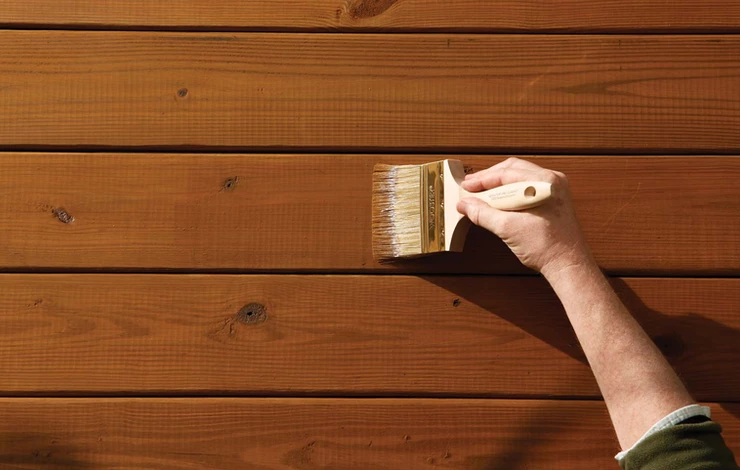When finishing a deck, there’s one major question on everybody’s minds – should you stain or paint? Staining vs. painting; here, we’ll try to answer this old question.
There’s a lot of debate as to which of these options is better when it comes to outdoor decks. Here at Deck Doc, we have detailed exactly which option is superior for decking so that you don’t get confused about your next job. Read on to find out who wins between staining vs. painting and why you should choose one over the other for your deck.
Staining vs Painting: A Question of Water
With decking, the first thing you need to bear in mind is that it will always be subject to the elements. Decking is outdoors, and the outdoors plays host to hail, snow, water, wind, and other aspects that could affect your build.
This is an essential aspect of the question of staining vs. painting in terms of rain. Your deck will get rained on at some point. That’s a guarantee.
You need to pick a waterproof finish to ensure your deck doesn’t get wrecked by rainfall. With paint, it simply doesn’t withstand the rain as well as staining.
Painted decks can begin to peel due to excessive rainfall, which ruins your finish. In worst-case scenarios, this would mean needing to repaint the whole thing again or replace the deck entirely.
But with staining, you’re not going to run into this problem. The main point of a deck finish and making your deck look great is making sure it lasts longer, and in that respect, you need to go with staining.
Winner: Staining is waterproof and therefore lasts longer.
How Does It Look?
With decking finishes, you want to make sure it looks great. Paint does offer more hues and colors than staining, but that makes your deck look garish.
Just because paint can look great on the walls of your house doesn’t mean it translates well to your deck. Decks simply look better when they have a more natural look that emphasizes the wood and materials they were built with.
With decking, overusing color isn’t as appealing as going for a well-finished natural look. Staining provides this natural look with ease, thanks to its application.
Staining gets into the very pores of your wood and accentuates the existing color it possesses. Not only that, but it can highlight some of the more natural bumps and grooves in the wood you’ve used also. This makes your deck look refined, rustic, and vivid, no matter the weather.
Winner: Staining provides a more natural look.
Does It Cause Any Rot?
When it comes to maintaining your deck, you need to avoid any form of wood rot at all costs. This can infect the foundations of your deck and mean you have to tear the whole thing out and replace it.
That causes a great deal more work than you want. It also weakens the deck’s structure, which can cause accidents in the long run.
When applying paint to a deck, it’s only a surface-level application. It sits on the top of the wood as an additional layer, rather than integrating entirely with the wood and its grooves.
This makes your wood more susceptible to wood rot. This happens when moisture, caused by rain or otherwise, leaks under the paint layer and into your wood. As we mentioned before, that layer of paint isn’t waterproof!
Staining provides a more comprehensive covering over your wood, thanks to its application. It gets into the grooves and binds itself to the shaping of your deck, rather than just sitting atop it.
This protects it better from moisture and prevents wood rot from affecting your decking. This means your deck lasts even longer than you’d hoped for and is less likely to discolor.
Winner: Staining prevents wood rot, whereas paint doesn’t protect from moisture well enough to prevent it.
Does It Create a Slippery Surface?
With a deck finish, you don’t want to affect the slipperiness of the surface too much. This can cause people to slip on your deck and hurt themselves, which is the last thing you want!
People might wrongly assume that staining a surface makes it slippery, but this isn’t the case. Staining tends to be flatter, and once they’ve appropriately incorporated into the wood, they don’t enhance slipperiness. This is thanks partly to how they integrate with the wood rather than lay atop it, as we mentioned in the above section.
Though it differs depending on which paint you use, painting your deck is more likely to make it slippery than staining. That means that not only is painting concealing the beauty of the wood you’ve used, rather than enhancing it like staining, it’s also making your deck more dangerous to traverse on the whole.
If you’re concerned about safety in your deck, this is an essential point, mainly if your deck is very high up, as any accidents could be more severe.
Winner: Staining is less slippery than paint and results in fewer accidents on your deck.
What’s the Verdict?
To conclude the argument of staining vs. painting, it’s clear to see that staining is the superior option for decking finishes.
It works to show off the beauty of the wood you’ve used for your decking rather than mask it in color. It’s also safer, thanks to being less slippery.
To add to that, it lasts longer because it’s waterproof and doesn’t trap moisture, meaning your wood is less likely to rot.
Now you know this. You want to know where to find staining services for your deck. Here at Deck Doc, we offer professional staining services for all decks, emphasizing preserving the quality of your decking.
To receive a free estimate on our deck staining service, make sure you contact us directly today!

